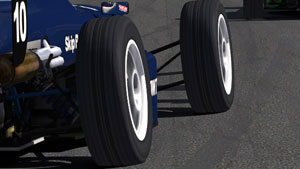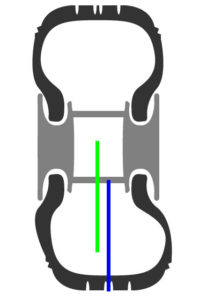 One of the few setup options available to the Skip Barber car is the pressure in the tyres. It’s also one of the most important things to get right on every single car. To find the ideal tyre pressure, it’s important to know what to look out for.
One of the few setup options available to the Skip Barber car is the pressure in the tyres. It’s also one of the most important things to get right on every single car. To find the ideal tyre pressure, it’s important to know what to look out for.
Tyre pressures influence a number of factors in the performance of the car, and both high and low tyre pressures have their drawbacks.
Factors: Deflection, contact patch, vertical and lateral stiffness
A tyre is a spring and damper unit after all, and becomes stiffer with higher tyre pressures. A higher tyre pressure also changes the curvature of the tyre, from a flat shape to like that of a bicycle.
Lower tyre pressures lower the vertical stiffness, which in turn causes a bigger contact patch (flatter tyre), and in theory sounds promising. Yet a bigger contact patch also increases the rolling resistance of the car. An even lower tyre pressure will cause the shoulders of the tyre to bare the grunt of the load, less than ideal (see illustration).

 Moreover, lower tyre pressures also affect the lateral stiffness, and when running very low pressures, it’s possible that the middle of the tyre is no longer at the centre of the rim while cornering. It can cause the sidewalls of the tyres to nearly fold. This is also not ideal (see image).
Moreover, lower tyre pressures also affect the lateral stiffness, and when running very low pressures, it’s possible that the middle of the tyre is no longer at the centre of the rim while cornering. It can cause the sidewalls of the tyres to nearly fold. This is also not ideal (see image).
This effect is most noticeable on the McLaren MP4-30 or Williams FW31, as they’re running on wheels with very tall sidewalls relative to their width. We recommend you take either of these for a spin on low tyre pressures, so you get familiar to the feeling of too-low tyre pressures.
Finding the balance
So, running low pressures has it’s drawbacks, as does having too high a pressure. As with almost every setup option that will be covered later on, some compromise is needed.
Fortunately, for the Skip Barber car and its tyres, finding the ideal pressure is fairly easy and does not depend on the track or weather conditions too much. We suggest you select a track, default weather and start a test session. Use the baseline setup, and drive a few laps to get the heat into the tyres. When the pressures stabilize, you have reached the stable operating temperature of the tyres. You have to use telemetry to find out after how many laps this takes. Let’s say that number is 4 laps. You’d need to drive 4 + 5 laps (4 laps to get the tires warmed up, then 5 clean laps within a few tenths of each other). Observe the car and check your laptimes.
Then increase the pressure a bit, and check behaviour and laptimes again. If the car is nicer to drive and/or quicker, go into the same direction with the pressure another time. If it’s worse and/or slower, go back to the original setting and then lower the pressure. Repeat this step until the improvement stops or the car becomes worse again.
The Skip Barber, as a non-downforce car, can be driven with the same pressure at practically every track. However, with higher end cars, especially those with high amounts of downforce, finding the right tyre pressure becomes a little more complex. A given tyre pressure is ideal for one specific amount of load on the tyres, yet this load varies greatly because of the different amount of downforce generated through high and low speed corners.
As a general rule of thumb, on tracks with lots of low speed corners such as Okayama, you’ll want to run relatively low pressures, because compared to high speed circuits like Spa, the downforce generated by the car is fairly low on Okayama, and therefore the loads on the tyres are lower. At a track with lots of high speed corners you may want to run higher pressures to increase grip in high-load situations.
When playing with the pressures you should be able to notice differences in traction in slow corners between higher and lower pressures. Likewise, you should notice a difference in grip in higher speed corners, although this might be more difficult to notice. Use the delta-bar to keep track of time gained or lost in individual corners.
Up to you:
The process of finding a good tyre pressure, at least for short runs, is the same iterative process as with the lower end cars. As you can already guess, for long runs it’s a little different and this will be covered later on in a more advanced section. Later on, we’ll also focus on temperature and weather differences.
For now, start your setup crafting career by finding the right tyre pressure. Continue with anti-roll bars, in 5.3.

